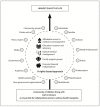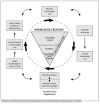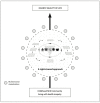We All Have a Role to Play: Redressing Inequities for Children Living with CAH and Other Chronic Health Conditions of Childhood in Resource-Poor Settings
- PMID: 33124614
- PMCID: PMC7711668
- DOI: 10.3390/ijns6040076
We All Have a Role to Play: Redressing Inequities for Children Living with CAH and Other Chronic Health Conditions of Childhood in Resource-Poor Settings
Abstract
CLAN (Caring and Living as Neighbours) is an Australian-based non-governmental organisation (NGO) committed to equity for children living with chronic health conditions in resource-poor settings. Since 2004, CLAN has collaborated with a broad range of partners across the Asia Pacific region to improve quality of life for children living with congenital adrenal hyperplasia (CAH). This exploratory case study uses the Knowledge to Action (KTA) framework to analyse CLAN's activities for children living with CAH in the Asia Pacific. The seven stages of the KTA action cycle inform a systematic examination of comprehensive, collaborative, sustained actions to address a complex health challenge. The KTA framework demonstrates the "how" of CLAN's approach to knowledge creation and exchange, and the centrality of community development to multisectoral collaborative action across a range of conditions, cultures and countries to redressing child health inequities. This includes a commitment to: affordable access to essential medicines and equipment; education, research and advocacy; optimisation of medical management; encouragement of family support groups; efforts to reduce financial burdens; and ethical, transparent program management as critical components of success. Improvements in quality of life and health outcomes are achievable for children living with CAH and other chronic health conditions in resource-poor settings. CLAN's strategic framework for action offers a model for those committed to #LeaveNoChildBehind.
Keywords: child; chronic; community; community development; congenital adrenal hyperplasia; human rights; inequity; non-communicable diseases; parents; poverty.
Conflict of interest statement
The authors declare no conflict of interest.
Figures



Similar articles
-
Living with congenital adrenal hyperplasia in Vietnam: a survey of parents.J Pediatr Endocrinol Metab. 2006 Oct;19(10):1207-23. doi: 10.1515/jpem.2006.19.10.1207. J Pediatr Endocrinol Metab. 2006. PMID: 17172082
-
Research on quality of life in female patients with congenital adrenal hyperplasia and issues in developing nations.J Pediatr Adolesc Gynecol. 2013 Dec;26(6):296-304. doi: 10.1016/j.jpag.2012.08.004. Epub 2013 Mar 16. J Pediatr Adolesc Gynecol. 2013. PMID: 23507003 Review.
-
[The analysis of psychological and social problems, the physical development in young people with congenital adrenal hyperplasia - owner experience].Pediatr Endocrinol Diabetes Metab. 2010;16(4):238-48. Pediatr Endocrinol Diabetes Metab. 2010. PMID: 21447264 Polish.
-
Living with an invisible illness: a qualitative study exploring the lived experiences of female children with congenital adrenal hyperplasia.Qual Life Res. 2020 Mar;29(3):673-681. doi: 10.1007/s11136-019-02350-2. Epub 2019 Dec 10. Qual Life Res. 2020. PMID: 31823183
-
Review article: freedom to lead a life we have reason to value? A spotlight on health inequity in the Asia Pacific region.Asia Pac J Public Health. 2011 Apr;23(2):246-63. doi: 10.1177/1010539511402053. Asia Pac J Public Health. 2011. PMID: 21398299 Review.
Cited by
-
Barriers to the Management of Classic Congenital Adrenal Hyperplasia Due to 21-Hydroxylase Deficiency.J Clin Endocrinol Metab. 2025 Jan 21;110(Supplement_1):S67-S73. doi: 10.1210/clinem/dgae710. J Clin Endocrinol Metab. 2025. PMID: 39836619 Free PMC article. Review.
-
The Editor's Choice for Issue 4, Volume 6.Int J Neonatal Screen. 2021 Mar 5;7(1):14. doi: 10.3390/ijns7010014. Int J Neonatal Screen. 2021. PMID: 33807537 Free PMC article.
-
Challenges in the treatment of late-identified untreated congenital adrenal hyperplasia due to CYP11B1 deficiency: Lessons from a developing country.Front Endocrinol (Lausanne). 2022 Dec 15;13:1015973. doi: 10.3389/fendo.2022.1015973. eCollection 2022. Front Endocrinol (Lausanne). 2022. PMID: 36589846 Free PMC article.
-
Factors influencing illness uncertainty in parents of children with congenital adrenal hyperplasia in a developing country: A cross-sectional study.Belitung Nurs J. 2023 Feb 12;9(1):54-61. doi: 10.33546/bnj.2379. eCollection 2023. Belitung Nurs J. 2023. PMID: 37469639 Free PMC article.
-
Differences of sex development.Nat Rev Dis Primers. 2025 Jul 31;11(1):54. doi: 10.1038/s41572-025-00637-y. Nat Rev Dis Primers. 2025. PMID: 40744924 Review.
References
-
- Speiser P.W., Arlt W., Auchus R.J., Baskin L.S., Conway G.S., Merke D.P., Meyer-Bahlburg H.F., Miller W.L., Murad M.H., Oberfield S.E., et al. Congenital Adrenal Hyperplasia due to steroid 21-Hydroxylase deficiency: An endocrine society clinical practice guideline. J. Clin. Endocrinol. Metab. 2018;103:4043–4088. doi: 10.1210/jc.2018-01865. - DOI - PMC - PubMed
-
- Brener A., Segev-Becker A., Weintrob N., Stein R., Interator H., Schachter-Davidov A., Israeli G., Elkon-Tamir E., Lebenthal Y., Eyal O., et al. Health-related quality of life in children and adolescents with Nonclassic Congenital Adrenal Hyperplasia. Endocr. Pract. 2019;25:794–799. doi: 10.4158/EP-2018-0617. - DOI - PubMed
LinkOut - more resources
Full Text Sources

